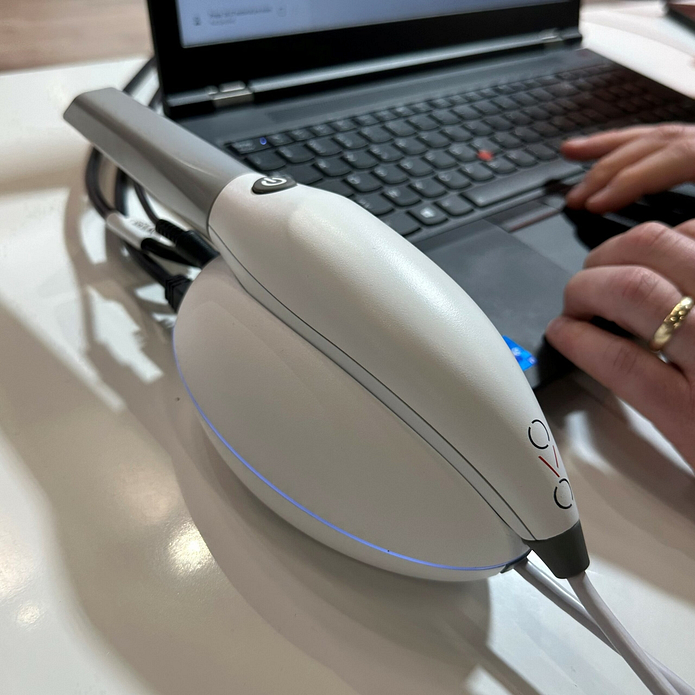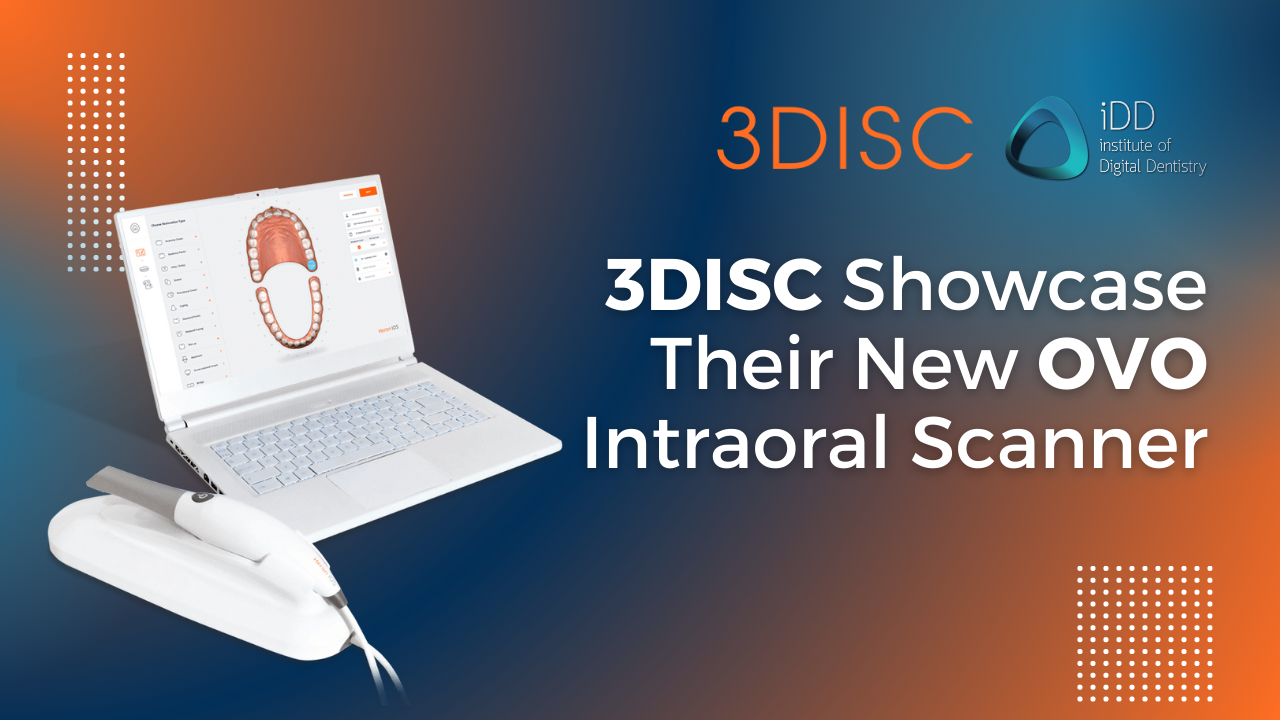We’ve covered 3DISC quite extensively here at the Institute of Digital Dentistry. We were fans of their intraoral scanner - the 3DISC Heron - but found it’s software a bit lacking.
While we were at IDS 2023, we caught up with 3DISC’s CEO Marie-Laure Pochon to talk about their new intraoral scanner - the OVO.
Hi there! Can you tell us a little bit about 3DISC’s new intraoral scanner - the OVO?
The OVO is an Omed product, created after 18 months of hard work.
You have three technologies inside the OVO. You have a scanner, a 2D camera that takes pictures and films, and also a software system which integrates and displays all the information that a can be shown to patients.
But of course I think the best is to show a demo. Eamonn Boyle, who is our software director, will explain.
The OVO has a very streamlined base. The hardware itself has been redesigned completely and we’ve built a new lighting system. All components have been updated, yet we’ve kept what we need from the essential optics chain to give us the precision we need. The scanner features enhanced colours, better final resolution in our data sets and overall, a more comfortable experience.
That builds on what we're calling our scan and communication hub, which is making it easier for the doctor and the patient to communicate about different elements. Being able to get a clear vision of what's going on in their mouth and to explain what needs to be done, and to look at a more predictable and preventative approach to dentistry, which we feel today has been missed by some of the other scanner manufacturers on the market who are focusing a lot more on restoration and aligners and other treatments for the patient.
We believe that using the scanner on a day-to-day basis offers a lot of benefits to our users.
With our new updated interface, you can easily navigate through your different patients. So one of the key features we have added is the ability to have our dedicated 2D mode at the beginning.
When the scanner's sitting just beside the chair, if you have a patient and you want to quickly show them something, you can just easily switch on your scanner. You take the scanner, you find an area where you want to take your image.
Then you easily take the image here and you build up the images you would like.
If you want to go into video mode, you just start the video and you can start to fill certain areas within the patient's mouth, so you can use this later while explaining treatment to the patient.
You can add-in different comments as well, just to remind you of what you need for later. You start to gather more images and data sets for your patients.
The updated software offers enhanced scanning and improved colour accuracy. Post-scanning, users can manage data more efficiently, generate a mesh, and access advanced tools.
A new feature allows designating areas for high-resolution scans, optimising precision in required areas.
The touchscreen-compliant interface enables easy 3D navigation. After scanning, images can be merged with patient data, allowing doctors to create comprehensive PDF reports.
Additionally, an iPad app facilitates data sharing in clinics and supports importing of extra 2D images.
How are you making this connection between the iPad and the software? Is it through a QR code?
In the settings, we have the ability for the user to see the QR code that they would scan. If you reset the server, you get the option, you take it.
Is this an Apple app?
It is an Apple app, yes.
What about Android devices?
At the moment we focus on Apple devices.
So that's what Marie-Laure was saying, The OVO package actually includes an iPad when you purchase it.

Does it work on phones?
It doesn't work on phones. We felt that from a visualization point of view, it's too small for use within a clinic. Also this way, it means that you can connect multiple iPads to the same database.
You're selling the iPad to the distributor with the product?
Yes, we felt that to give a full communication package, it made a lot of sense to give them everything they needed from the beginning.
But the user would still need to buy a laptop?
Yes.
Our analysis was that the market has not developed as we all expected it to develop. Which means that when we were in 2019 or 2018, we thought that all the dentists would be equipped in three years time or five years time, which has not been the case.
We think this is because most dentists are not ready to spend $15,000 for a device, which is normally the work of a lab and is not a clinical tool. And we want to provide dentists a real clinical tool that is good for them with their patient relation and the acceptance of treatment. That's the work we have done. We have combined three technologies as I said, a scanner, a camera, and a software that displays information.
What’s the recommended retail price of the OVO intraoral scanner?
$16,000.
That includes the iPad?
Yes, of course.
So quite competitively priced.
Indeed!
I've tested a lot of scanners and they all try to do some sort of patient communication. The big focus with patient communication has been Apps, Smile Design and Orthodontics. The iPad is a great idea because I definitely could hand this over to your patient and show them quite effectively rather than fumbling on a laptop.
It's the way we present it definitely. The software, scan and everything else is patented.
We're working on a way that we feel will help drive scanner adaptation. Part of our key focus is we feel that digital offers a lot of benefits, but we want to increase the benefits on a day-to-day basis within the clinic.
Is there anything else to showcase?
We're looking at patients evolving dentition over time. So we've come up with what we're calling a vocal monitoring tool. We see there are initial dentitions. We can also see the reductions that have been done for the veneering, and we can see the final veneers.
we can then launch what we're calling book and monitoring, which is our full patient mouth tool that allows you to be able to see the changing evolutions in the patient's mouth over time.
We feel five years ago maybe it wasn't the ideal tool to launch, but now when you talk to people, they have historical records with different scans and patients coming back.
There's also the ability to see if the soft tissue changed over time? Is there a little bit of recession in the soft tissue? We're trying to put together a simple interface that takes two data sets over a period of time and allows the doctor to be able to look and say things have changed in a positive way or a negative way.
This is only with HERON scans or OVO scans?
OVO scans, yes.
Can you use old HERON scans or not?
The software has improved for HERON. We have improved the scanning speed, we've improved the scanning color, we've added some additional smaller features.
But this is for OVO?
The communication package with OVO is how to better communicate. It's giving us, an ability to position ourselves with doctors who want the scan. We have one product. We have a second product for the doctors who want to take it a step further, use it on a day-to-day basis. Use it as a communication tool. It's setting us in a position where we have two products, depending on what the doctor wants.
Will you continue to sell the HERON intraoral scanner?
Yes. It's a very popular product and we want to keep selling it and we will keep updating and improving that software over time as well.
That is everything from the 3DISC team. As you can see, quite an interesting offering here with OVO, with the focus really being patient communication and interaction. Thanks a lot guys.
More than welcome.
I look forward to reviewing this.
Thank you very much for your visit.

